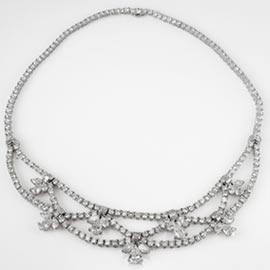
Whether you’re an aspiring jewelry collector or you’re on the market for some nice gold wedding jewelry or a conversation piece, you may find that estate jewelry has a lot to offer.
“Estate” simply means that the jewelry has been owned before, so many of the pieces are on the older side and have a lot of character to them. However, since the term “estate jewelry” can describe pieces that are a few years old or a few hundred, let’s explore some of the time periods that estate jewelry often falls into.
Before getting into each individual time period, let’s first clarify some terminology. According to the Jewelry Business Advisor, to qualify as antique, a piece must be at least one hundred years old. To qualify as vintage, it must be more than twenty years old, and should be representative of its period of origin.
Now, we’ll delve deeper into some of the periods themselves. Although jewelry dates back thousands of years, this article will focus only on the periods of jewelry you are most likely to encounter in today’s marketplace.
Victorian (1837-1901)
The Victorian era is a treasure trove of antique gold jewelry, as many pieces featured gemstones set in intricate golden designs. Early Victorian estate jewelry typically use smaller gemstones, but in the mid-to-later part of the era, larger gems were favored. Diamond jewelry was also popular during this time.
Edwardian (1890-1920)
Overlapping with the end of the Victorian period, Edwardian styles were favored by royalty. Diamond jewelry is the most prominent, though platinum was usually favored over gold. Most of these pieces (barring only the very tail end of the era) qualify as antique in 2016.
Art Deco (1920-1935)
In the Roaring Twenties, geometric patterns and bright gemstones (real and synthetic) were favored. There is some gold jewelry to be found, but platinum was still popular. As of 2016, this jewelry qualifies as vintage, but not antique.
Retro (1935-1950)
During WWII and the years that followed, the style of jewelry took a distinct turn toward the modern. Gold become favored once again, but instead of pure gold, jewelers created alloys (of which rose gold was one of the most popular).
Gemstones were on the larger side, though a good deal of retro vintage jewelry uses cheaper, less rare gemstones (aquamarine, topaz, etc.), making the pieces more affordable. However, retro pieces featuring diamonds, emeralds, rubies, and other precious gems can be found as well.
Contemporary (1950-present)
Depending on its specific year of origin, contemporary jewelry may or may not qualify as vintage. It is not limited to a single style, as it encompasses a time period characterized by diversity. Thus, contemporary estate jewelry may be large, made of gold, and diamond-heavy, or simple, delicate silver with small jewels (or anything in between).
Exploring the jewelry market outside the modern stores can allow you to find beautiful gold jewelry that has a unique look and a fascinating history. Be aware, though, that there are many reproductions floating around, so have your acquisitions examined by an expert to confirm their authenticity before you buy.